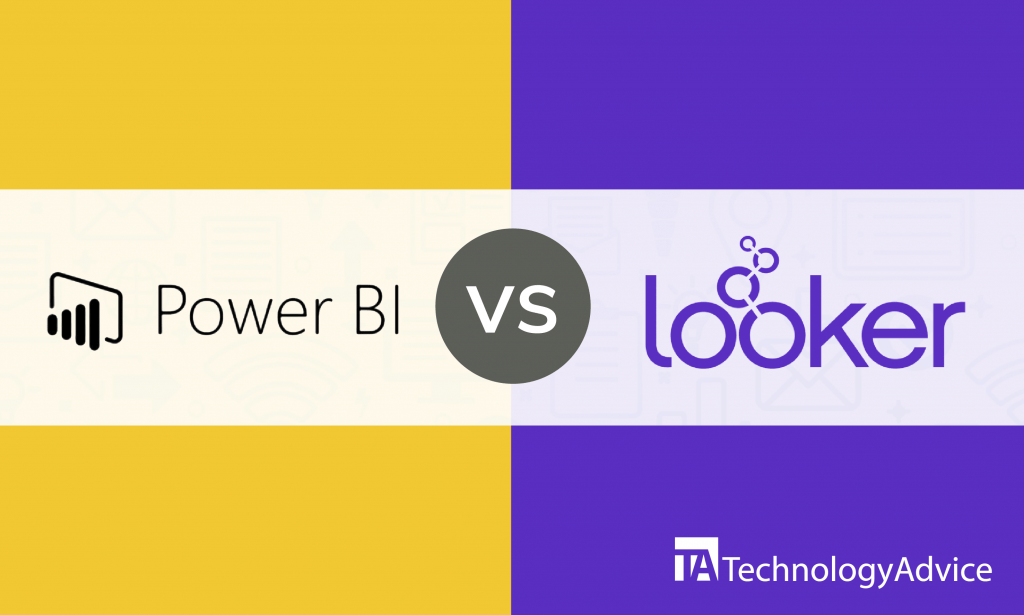- categoryBusiness Intelligence
- ContentComparison
In the last two decades, the business intelligence industry has radically transformed the way we look at data. Advanced data analytics technologies help businesses improve their processes and move their industries forward with data-driven insights for better decision making.
At present, Microsoft’s Power BI leads the industry. And Looker, recently acquired by Google, has been in the field since 2012 and will likely become a juggernaut.
But first, if you’re looking for the right BI software for your business, check out our Product Selection Tool. Enter your feature, price, and user requirements and we’ll send you the list of BI tools that might suit your business. Getting your business intelligence software recommendations is free and takes five minutes or less.
Power BI vs. Looker: An overview
Power BI’s initial release in 2014 was a signal to the tech world that Microsoft was serious about dominating the market in the coming years. And so far, they’re as good as advertised. Power BI is the BI software to beat. On the other hand, Looker has built itself as one of the key industry players. And with Google’s $2.6 billion acquisition of the company, Looker’s future shines bright.
But should it be Power BI vs Looker? We’ll examine their main features — how they’re the same and how they differ.
Read also: Choosing The Best CRM Platform: Vendors And What Features To Look For
Experiencing data in the dashboard
Both systems offer engaging and impressive dashboards. Power BI’s user interface is intuitive and easy to use and features drag-and-drop modules. It offers a feature that helps you with customizing the dashboards, data tools, visuals, and reports, and collaborating with your teams.
Looker lets you conduct in-depth analysis in real-time thanks to interactive dashboards. Dashboards let you easily access data and data tools to make stunning visualizations and customized reports. You can also efficiently collaborate and integrate insights with others on your team.
Customizing and simplifying data
Power BI features advanced data analytics and modeling tools that simplify complex data sets from multiple sources into beautiful and interactive visualizations. You can build easy-to-understand reports and share data, visuals, and insights across your organization in real-time.
Looker offers similar features with Power BI, featuring data-driven workflows that save you time and money. You can also customize applications and embed data with its pre-built tools and templates for creating visuals and reports you can share with people across your organization and your clientele.
Visualization and storytelling
Data tells a story. With the right data tools, you can tell engaging stories with visuals, communicate data clearly and effectively, and generate insights that lead to actions that impact business. Both Power BI and Looker offer excellent story-telling capabilities with their pre-built tools that enable you to create stunning interactive visuals like graphics and charts.
Accessibility, integrations, and collaboration
With Power BI, you can access your data anywhere, anytime, and on any device. It integrates with other Microsoft products like Excel, Dynamics 365, Azure, and Sharepoint. It also integrates with third-party platforms like Salesforce, Mailchimp and Google Analytics. Everyone on your team can access data so you can collaborate and share insights.
With its unique digital infrastructure design, Looker infuses and integrates data into your operational workflows to make it easy to collaborate and share with your team. You can create impressive visuals and interactive dashboards that people can access whether they’re in the office or on the go. Looker integrates with other third-party data platforms, productivity tools, and databases. These include Slack, Dropbox, Salesforce, Confluence, Sharepoint, Snowflake, Redshift, BigQuery, and other supported SQL dialects.
Data security
Power BI and Looker prioritize data security, ensuring compliance with global regulatory standards. Both of them utilize row-level security. Power BI has dual repositories for storing and managing data. One repository is Azure BLOB storage, which stores users’ data, and the other is Azure SQL Database, which stores metadata and system artifacts. Looker uses AES 256-bit encryption, and like Power BI, it is SOC2 Type 2 and ISO/IEC 27001 compliant.
Data monetization and scalability
With data at your fingertips, both Power BI and Looker let you earn from data analytics by providing your clients with data-driven insights to improve and move their businesses forward. Power BI provides flexibility as it lets you customize based on your individual or team needs, and you can scale it up or down depending on your requirements. Looker is a full, self-service enterprise BI that lets you analyze large data sets, deploy across multiple clouds and databases, and create custom reports to send to your customers.
Should it be Power BI vs. Looker?
Both BI systems offer equally reliable and high quality data tools with slight variations on applicability.
If you’re already familiar with other Microsoft products, Power BI might be a better choice, as you’ll find the user experience comparable to other Microsoft tools. But Looker offers out-of-the-box data solutions and more integrations with other third-party platforms and productivity tools. As Microsoft and Google race toward the top, we can only expect more advances in the years to come as they lead the industry to new grounds in business intelligence and data analytics.
Looking for a BI solution for your business? Use our Product Selection Tool. We did the research for you to provide quick access to product information to save you time.
